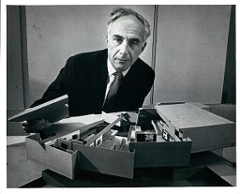
Hans Peter Selz
Director of the Berkeley Art Museum and Pacific Film Archive
Professor of the History of Art, Emeritus
Peter Selz, an internationally celebrated art historian, was the founding director of what today is the Berkeley Art Museum and Pacific Film Archive (BAMPFA) at the University of California, Berkeley.
He was born on March 27, 1919, in Munich Germany. From his humble beginnings as a Jewish-German immigrant who fled Nazi Germany for the United States in 1936, Selz rose to become one of the most distinguished scholars and curators of the postwar art scene, developing close friendships with some of his generation’s most influential artists—including Mark Rothko, Willem de Kooning, Sam Francis, Christo, and many others.
Selz studied art history at the University of Chicago on the G.I. Bill, leading to a master’s degree in art history in 1949. In 1954, he was awarded a Ph.D. in modern art history for his 600-page dissertation, which became an influential book entitled, German Expressionist Painting (UC Press, 1957). He held professorships at multiple prestigious universities. He was twice awarded Fulbright grants to study in Paris during this first decade of notable scholarship.
Selz moved to New York in 1958 to become the Curator of Painting and Sculpture at the Museum of Modern Art. The position put him at the crux of powerful crosscurrents that were reshaping the New York art scene, from the influence of Abstract Expressionism to the rise of Pop art and Conceptualism. With a restless intellectual curiosity that would come to characterize his curatorial practice, Selz used his platform at MoMA to highlight work by an eclectic range of important artists, mounting influential midcareer surveys of Rothko, Jean Dubuffet, and Alberto Giacometti, among others.
In 1965, Selz accepted an invitation from the University of California to move to Berkeley and become the founding director of the museum that later became BAMPFA. What was then called the University Art Museum was conceived in the early 1960s to showcase the University’s growing art collection, which had recently been transformed by a gift from Hans Hofmann of nearly 50 of the artist’s finest works. As the museum’s first director, Selz was intimately involved in shaping the institution literally from the ground up—from engaging the renowned architect Mario Ciampi to design the iconic modernist building, to partnering with the film director and scholar Sheldon Renan to establish the Pacific Film Archive at the heart of the museum’s program.
During his nearly decade-long tenure as founding director, Selz launched the museum on an ambitious course, more than doubling the size of its collection with the addition of many Old Master, Modern, and contemporary masterworks and mounting massive exhibitions that took full advantage of the museum’s cavernous 100,000-square-foot facility. As his daughter Gabrielle Selz later observed, her father’s curatorial approach in Berkeley defied many of the fashionable art world trends of the 1960s; as the New York art scene deepened its embrace of Pop and Minimalism, the University Art Museum under Selz’s leadership celebrated the emergence of the countercultural Funk art movement with the massively influential group exhibition Funk in 1967. Selz also championed the work of figurative artists like Nathan Oliveira and ceramicists like Peter Voulkos, who went on to acclaim despite working against the prevailing abstractionist trends of the period. As a professor in Berkeley’s Department of Art History, Selz continued to distinguish himself as a scholar and essayist, authoring books and exhibition catalogs on Sam Francis, Ferdinand Hodler, German and Austrian Expressionism, and many other topics.
In 2014 his daughter added, “I often say, that even though he has been married five times, he is really only been married to art (In fact, he wears an eyeball ring instead of a wedding band because to him it symbolizes the ‘eye’, the gazer, the one who assess and judges with his eyes.)”
Selz concluded his tenure as the museum’s director in 1973 but continued to teach modern art at Berkeley, retiring as an emeritus professor in 1988. He remained a major force in the Bay Area art scene. For example, the environmental artists Christo and Jeanne-Claude, engaged Selz as the project director of their ambitious installation Running Fence—a 24.5-mile long fabric fence crossing the Marin County hills, which was completed in 1976.
Holding the position at BAMPFA that Peter once held, I can see that he transformed this institution from a modest university art collection into an internationally-renowned art and film institution. Generations of Bay Area art lovers have already benefited from his insight, knowledge, independence, and boundless energy. A large and affectionate audience gathered at BAMPFA to honor Peter on his 100th birthday. Here he made his last public appearance. On that spring day in 2019, just weeks before his death, Peter told museum visitors to think of the future, “I can say there’s a lot of very, very good art being produced now, a lot of surprises … I have felt optimistic about art all my life.”
He died on June 21, 2019, and was survived by his fifth wife, Carole Schemmerling, daughters Tanya Selz and Gabrielle Selz, stepdaughters Mia Baldwin and Kryssa Schemmerling, four grandchildren, and one great grandson.
Lawrence Rinder
2020
